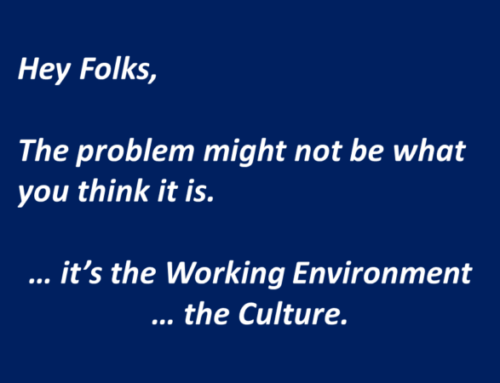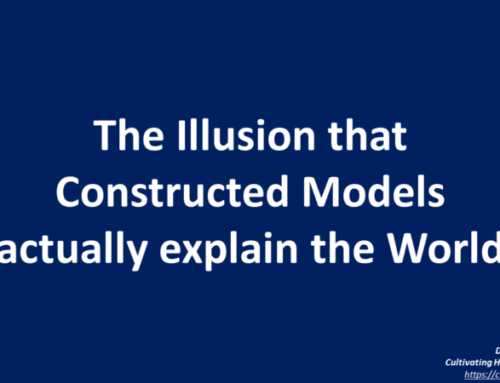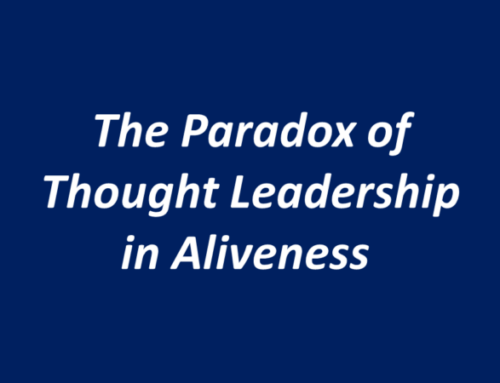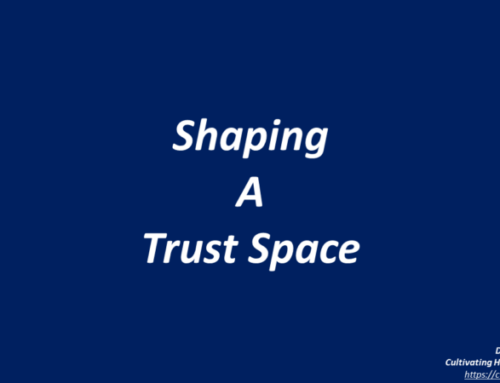Why Facilitation?
One of my most important learnings in 40 years of working with groups is that …
The group always knows best,
even if it doesn’t know that it knows.
I’ve learned the importance of being conscious of and using the collective wisdom of the group, which, when working with groups, ultimately defines my role as … creating the space for this wisdom to emerge.
For complex challenges such as …
- wicked problems
- stuck situations
- new directions
- openings
- territory you have never visited before
- …
… I have yet to experience an alternative approach that works.
Let’s be clear on the true role of a facilitator:
A facilitator creates and holds the space to enable a group to focus on finding responses to their challenges.
S/he provides orientation, focus and structure for an event/meeting. Interventions are limited to focus and possibly relationships. Most interventions take the form of Questions. Suggestions to the group are genuine invitations.
The group owns all content as well as any outcomes. Facilitators free themselves of all interest in the outcomes. A facilitated intervention is not a process.
Opening an emergence space uncovers the wealth, the treasures hidden beneath the surface; the treasures waiting for an opportunity to contribute.
Perhaps this all sounds somewhat esoteric. The following examples illustrate the concrete benefits of this approach.
Construction of a New Airport in Asia
In the 1990s, I was requested to travel to Asia to mediate in a dispute among consortium partners that was preventing a new, almost complete airport from opening. The technical issue concerned safety. I am not an engineer so obviously could not make any useful contribution whatsoever to the technical discussions. During the preliminary negotiations, my gut feeling informed me that the real issue lay beyond the topics being discussed. Both the lead consortium partner and the client wanted a directive workshop to “force” (their words) the engineers to solve the problem. Understandably, they were nervous. As well as a great deal of money, prestige was also at stake. I resisted and finally managed to, (a) negotiate all commercial managers out of the meeting; (b) persuade them that we should trust in engineers’ pride in wanting to find solutions to challenging problems.
We scheduled 3 days for the meeting with a clear desired outcome: solve the technical problem so the airport would be able to open.
The initial phase surfaced the diverse range of perspectives on contractual responsibilities for the various units of equipment. Simultaneously, the interdependence suddenly became clear to everyone. At this moment, only the group could decide how to move forward. They looked at me. I looked at them and simply asked: “What do you want to do now?” I then poured myself a coffee and waited outside in the lobby. 20 minutes later, the group came out, stating that they wanted to try to solve the problem together. They requested me to simply stay in the room and ensure they remained focused, while they devised the tests that the test centre needed to run to solve the technical problem. I did.
The real problem emerged. It was political rather than an engineering problem. Commercial and corporate politics had resulted in the technical impasse. Tensions increased. Nevertheless, they maintained their commitment to finding a solution together.
Result: the engineers solved the problem. The airport opened on time.
Why Facilitation?
Quite simply, opening the space for the group to find their answer was the ONLY approach that could have led to this successful outcome. The answer was in the space, the liminal. Any attempt, however slight, to be directive would have killed the initiative … and … probably resulted in a multi-million dollar legal dispute.
Aligning the Senior Management Team with the Strategy
There appeared to be no significant problems. The business unit was profitable; the senior management team, an experienced group of people from six countries, seemed to be getting along fine; the Managing Director was liked and respected by all; yet during the workshop in which he presented the new corporate-driven strategy, something was bubbling beneath the surface. Everyone was aware of it, no one could pinpoint it, the Managing Director was concerned. They were stuck. I made an intervention. “What’s preventing us from moving forward?” I asked. I suggested a dialogue circle.
The “problem” emerged from the circle. It was trivial yet highly significant. While personal relationships among the group members were fine, the way in which two members of the team dealt with business problems resulted in tensions among them all: they were bound by intricate webs of interdependence. The dialogue circle, including one long period in which not a word was spoken, was the space that enabled both members to voice the inhibitions that drove their defensive aggressive behaviour. The problem dissolved.
Why Facilitation?
If I or the Managing Director had made any attempt to moderate the situation, the problem would have merely been suppressed and almost certainly would have arisen again. The answer was in the space, the liminal.
A New Innovation Unit
A traditional family-owned engineering company in the industrial heartland of Germany was suffering. Turnover had been decreasing for some years as its core technology for the energy sector became outdated. They did however possess a dedicated workforce of highly skilled engineers and decided to form a new Innovation Unit led by an experienced manager headhunted specifically for this role.
The CEO, a grandson of the founder, wanted to issue the Innovation Unit with clear instructions and processes. The Unit Leader and I (external consultant) resisted, arguing that, (a) innovation requires free space, experimentation and trust; (b) the group will only truly engage if they feel ownership of their work; (c) this is a unique opportunity for the members of this newly formed unit to develop a vision that they will engage with. After much discussion, the CEO allowed us to go ahead … and was completely surprised with the outcomes of our initial workshop.
Why Facilitation?
Embarking on a new unknown direction, the Innovation Unit needed a clear focus and space. Any attempt to direct them would have been a contradiction to the stated aim of innovation. We trusted them to want to contribute … and they did.
*********
Moderating a group involves exercising control. In some situations, it may be appropriate.
When entering an unknown space, we need to trust groups to find their own way. They will.
We can contribute best by practicing the Art of Facilitation.
The distinction between the roles of Facilitator and Moderator is clarified here: http://cultureqs.com/facilitator-moderator-consultant-trainer-clarify-your-role/.
You may download this post as a pdf here: Why Facilitation for pdf






